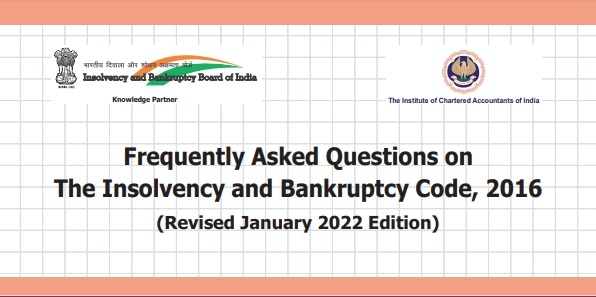Publication: Frequently Asked Questions on The Insolvency and Bankruptcy Code (IBC), 2016 (Revised January 2022 Edition) by CIBC of ICAI in collaboration with IBBI
Message
The insolvency space is extremely fertile, especially in a growing market economy, like India. It acquires richness, depth and maturity with every transaction. The insolvency regime in India is no exception. The Insolvency and Bankruptcy Code, 2016 (Code) has witnessed six legislative interventions since its enactment, to strengthen the processes and further its objectives, in sync with the emerging market realities. There have also been dozens of amendments to the regulatory framework to smoothen the
implementation of various processes under the Code. The Adjudicating Authority, the Appellate Authority, High Courts, and the Supreme Court have all delivered numerous landmark orders and judgments explaining several conceptual issues, settling contentious issues and resolving grey areas. The insolvency as a discipline of knowledge is now well established in India.
A key pillar of the insolvency ecosystem is the regulator, namely, the Insolvency and Bankruptcy Board of India (IBBI). The regulator is responsible for professionalizing the insolvency services through regulation and development of a comprehensive ecosystem of service providers, including, insolvency professionals, insolvency professional agencies, information utilities, registered valuers, and registered valuers’ organizations. It has been the endeavor of IBBI to ensure that the service providers are fit-and-proper
persons, academically qualified and technically competent, and also have the necessary motivation and drive to uphold the highest standards of ethics and professionalism. In pursuance of this responsibility, the IBBI has been undertaking several activities to build the capacity of service providers, and monitoring their conduct and performance closely.
IBBI was set upon 1st October, 2016 with a mandate to commence the corporate insolvency proceedings by 1st December,2016, and in just sixty days, it had to create the entire ecosystem comprising Insolvency
Professionals Agencies (IPAs), Insolvency Professionals (IPs), regulations for processes, and so on. IBBI could successfully deliver on this mandate with the active support and cooperation of the Institute of Chartered Accountants of India, which promoted IIIPI to join the insolvency ecosystem, as the first IPA, in November, 2016. IIIPI has achieved a leadership position in terms of membership and number of assignments handled by its members. IIIPI, apart from being a wholly owned subsidiary of ICAI, is the largest IPA with over 60% share of membership across IPAs.
The contribution of ICAI towards building the Indian economy and its steady growth is well established and known to all. In successful implementation of IBC, ICAI has played crucial role.
I congratulate the IBC Committee of the Institute of Chartered Accountants of India for engaging with IBBI for this joint initiative, in bringing out this revised handbook on Frequently Asked Questions (FAQs) on the Insolvency and Bankruptcy Code, 2016, appropriately supplemented with Case Laws. The handbook is expected to provide useful guidance to the members of the profession and other stakeholders for clear interpretation and understanding of the insolvency law. The inclusion of section wise jurisprudence in this revised edition will surely add to the utility of the publication.
I compliment Mr. Nihar Jambusaria, President ICAI; Dr. Debashis Mitra, Vice President, ICAI; CA. Durgesh Kabra, Chairman, Committee on IBC of ICAI; and CA. Prakash Sharma, Vice Chairman, Committee on IBC of ICAI , Ms S. Rita, Secretary, Committee on Insolvency and Bankruptcy Code and the authors who supported ICAI in preparation of this Handbook. My compliments to the team IBBI comprising Mr. Amit Pradhan, ED, Mr. Rajesh Kumar Gupta, CGM and Mr. Raghav Maheshwari, AM for their support in
bringing out this publication.
I sincerely believe that the insolvency professionals, prospective insolvency professionals and other stakeholders including researchers and students of insolvency and bankruptcy would find this Handbook useful.









